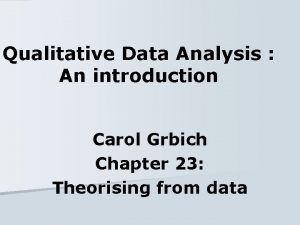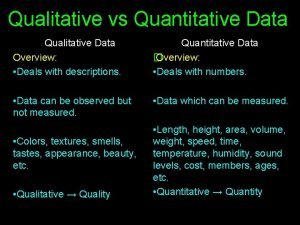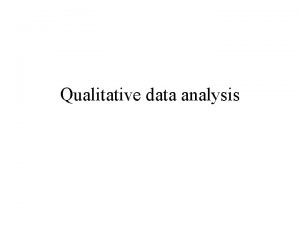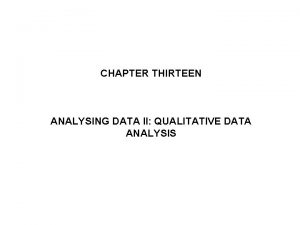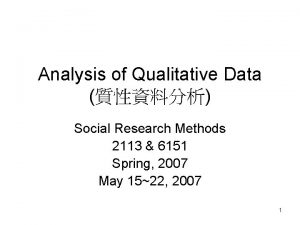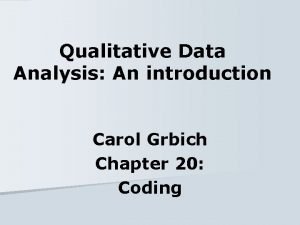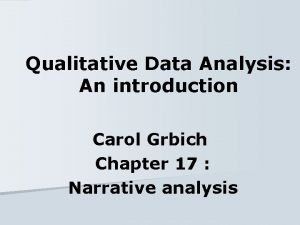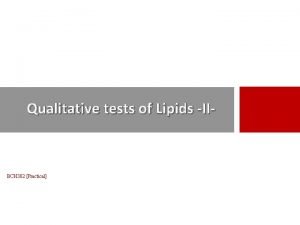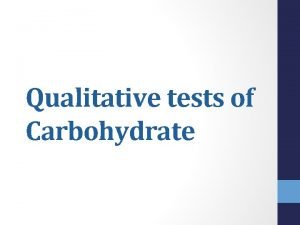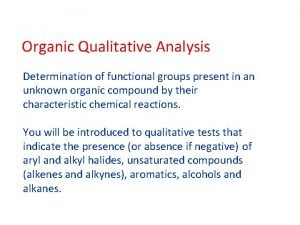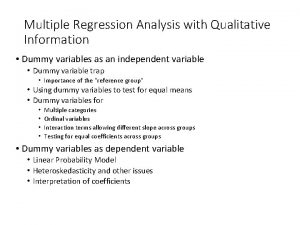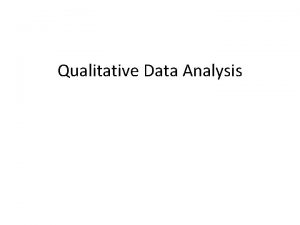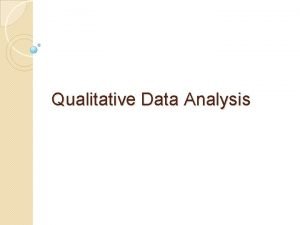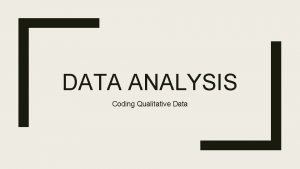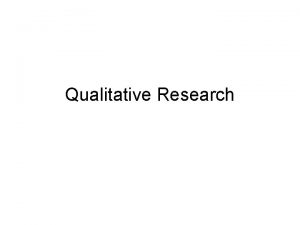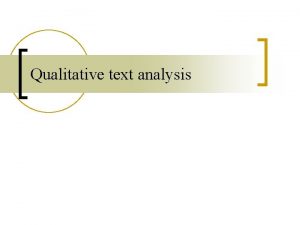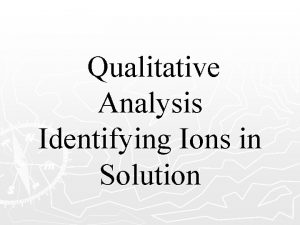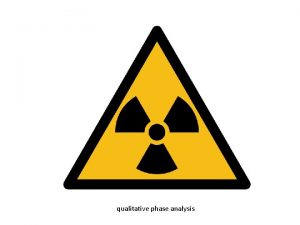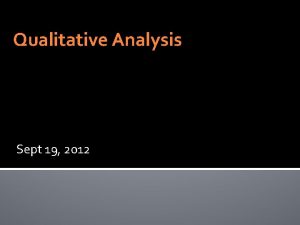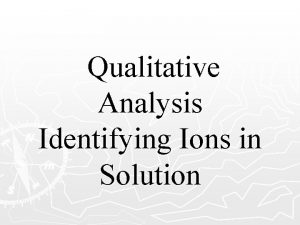Chapter 9 Qualitative Data Analysis Mc GrawHillIrwin Copyright




















- Slides: 20

Chapter 9 Qualitative Data Analysis Mc. Graw-Hill/Irwin Copyright © 2013 by The Mc. Graw-Hill Companies, Inc. All rights reserved.

Learning Objectives • Contrast qualitative and quantitative data analyses • Explain the steps in qualitative data analysis • Describe the processes of categorizing and coding data and developing theory • Clarify how credibility is established in qualitative data analysis • Discuss the steps involved in writing a qualitative research report 9 -2

Nature of Qualitative Data Analysis • Qualitative research is useful in providing knowledge for decision makers – When the purpose of a research project is to better understand psychoanalytical or cultural phenomena 9 -3

Qualitative Versus Quantitative Analyses Qualitative Data • Textual and visual • Goal - to understand the analysis • Ongoing and iterative • Employs member checking • Inductive in nature Quantitative Data • Numerical • Goal - to quantify magnitude of variables and relationships • Guided entirely by the researchers 9 -4

Member Checking • Asking key informants to read the researcher’s report to verify that the analysis is accurate 9 -5

The Process of Analyzing Qualitative Data • Researchers engage in a three-step process of analysis: – Data reduction – Data display – Conclusion drawing/verification 9 -6

Exhibit 9. 1 - Components of Data Analysis: An Interactive Model 9 -7

Step 1: Data Reduction • Categorization and coding of data that is part of theory development process in qualitative data analysis – Consists of many interrelated processes: • • • Categorization and coding Comparison Theory building Iteration and negative case analysis The role of tabulation 9 -8

Relevant Key Terms Categorization Placing portions of transcripts into similar groups based on their content Code Sheet Lists the different themes or categories for a particular study Codes Labels or numbers that are used to track categories in a qualitative study Comparison Developing and refining theory and constructs by analyzing the differences and similarities in passages, themes, or types of participants Integration Moving from the identification of themes and categories to the development of theory 9 -9

Relevant Key Terms Recursive A relationship in which a variable can both cause and be caused by the same variable Selective Coding Building a storyline around one core category or theme; the other categories will be related to or subsumed to this central overarching category Iteration Working through the data several times in order to modify early ideas Memoing Writing down thoughts as soon as possible after each interview, focus group, or site visit Negative Case Analysis Deliberately looking for cases and instances that contradict the ideas and theories that researchers have been developing 9 -10

Step 2: Data Display • Common types of displays: – A table that explains central themes in the study – A diagram that suggests relationships between variables – A matrix including quotes for various themes from representative informants 9 -11

Step 3: Conclusion Drawing/Verification • Credibility in qualitative research – Emic validity: Affirms that key members within a culture or subculture agree with the findings of a research report – Cross-researcher reliability: The degree of similarity in the coding of the same data by different researchers 9 -12

Step 3: Conclusion Drawing/Verification • Credibility: The degree of rigor, believability, and trustworthiness established by qualitative research – Triangulation: Addressing the analysis from multiple perspectives • Using: – – – Data collection and analysis Multiple data sets Multiple researchers Multiple time periods Different kinds of relevant research informants 9 -13

Step 3: Conclusion Drawing/Verification • Peer review: A process in which external qualitative methodology or topic area specialists are asked to review the research analysis 9 -14

Exhibit 9. 9 - Threats to Drawing Credible Conclusions in Qualitative Analysis 9 -15

Writing the Report • Contains three sections: – Introduction • Research objectives • Research questions • Description of research methods – Analysis of the data/findings • Literature review and relevant secondary data • Data displays • Interpretation and summary of the findings – Conclusions and recommendations 9 -16

Writing the Report • The methodology section of a qualitative report contains: – Topics covered and materials used in questioning – Locations, dates, times, and context of observation – Number of researchers involved and degree of involvement – Procedure for choosing informants 9 -17

Writing the Report – Number of informants and informant characteristics – Number of focus groups, interviews, transcripts – Total number of pages, pictures, videos, and researcher memos – Procedures used to ensure systematic data collection and analysis – Procedures used for negative case analyses – Limitations of methods 9 -18

Writing the Report • Analysis of the data/findings – Sequence of reported findings should be written in a way that is logical and persuasive – Data displays that summarize, clarify, or provide evidence for assertions should be included with the report • Verbatims: Quotes from research participants that are used in research reports 9 -19

Exhibit 9. 10 - Making Recommendations Based on Qualitative Research When Magnitude Matters 9 -20
 What are the characteristics of a qualitative research
What are the characteristics of a qualitative research Chapter 10 qualitative data analysis
Chapter 10 qualitative data analysis What is quantitative example
What is quantitative example Qualitative vs quantitative data analysis
Qualitative vs quantitative data analysis Principles of qualitative data analysis
Principles of qualitative data analysis Quantitative vs qualitative data collection
Quantitative vs qualitative data collection Thematic analysis in qualitative research
Thematic analysis in qualitative research Qualitative coding examples
Qualitative coding examples Qualitative data analysis coding
Qualitative data analysis coding Quantitative research design example
Quantitative research design example Sample qualitative data analysis report
Sample qualitative data analysis report Qualitative data analysis
Qualitative data analysis Narrative data analysis example
Narrative data analysis example Qda software open source
Qda software open source Qualitative research holistic
Qualitative research holistic Power bi qualitative analysis
Power bi qualitative analysis Qualitative tests for lipids
Qualitative tests for lipids Qualitative test for carbohydrate
Qualitative test for carbohydrate Qualitative analysis of organic functional groups
Qualitative analysis of organic functional groups Multiple regression analysis with qualitative information
Multiple regression analysis with qualitative information General chemistry with qualitative analysis
General chemistry with qualitative analysis

